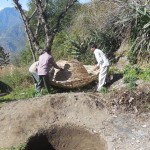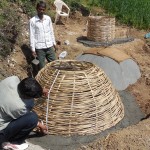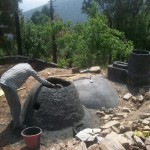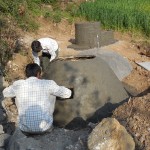INSEDA
Carbon Credits under the Gold Standard for Household Biogas Plants
 Placing Bamboo base of biogas plant
Placing Bamboo base of biogas plant
 Coating with Cement Mortar
Coating with Cement Mortar
 Masons at work with biogas installation
Masons at work with biogas installation
 Reinforcing biogas plant
Reinforcing biogas plant
 Close to Completion
Close to Completion
INSEDA’s Gold Standard VER project was aimed at mitigating greenhouse gases (GHGs) by implementing household bio-digesters and increasing the functionality rate of the biogas plants by bundling household anaerobic biogas plant installed in the rural areas of Kerala and Madhya Pradesh. Biogas generated from the bio-digesters helped in replacing firewood used for domestic cooking purposes, thus improving the quality of air in the cooking space and also reducing the drudgery of women. This project perfectly illustrates the immense benefits to be gained for participants in the Gold Standard VER (Voluntary Emission Reduction) process and the potential for sustainable, nationally appropriate mitigation activities.
However, the present process of the lengthy registration, and verification & certification processes has serious shortcomings, particularly for the project developers. The extensive reliance on external agencies for the detailed documentation for every step is prohibitively expensive; problematicgiven a rural setting; and time consuming for small project developers. The absence of funding or a financial safety net (for instance, the lack of a provision allowing advance payments from buyers to ease monetary pressures on participants) can impede the smooth functioning of the process. It is recommended that, in keeping with the constraints of grassroots compulsions and finances, Gold Standard process should be reformed and simplified and a funding process should be put in place. Without addressing these concerns, the most valuable mitigation projects (which are in rural areas) will end up being excluded from this process.
It is also recommended that there is a need for appropriate capacity building of NGOs and other grassroots stakeholders involved in the carbon credit project. 4,000 biogas plants save 16,000 tons of CO2 in project areas in the Indian states of Kerala and Madhya Pradesh The involved NGOs could support the development of 10,000 biogas plants/year, leading to extra savings of 40,000 tons/year, after 10 years this will add up to 400,000 tons/year of GHG savings. Investments are 300 €/plant, and can then save costs of other cooking fuels (mainly reduced work) and can receive 100 – 150 € of climate credits over 10 years Present greenhouse gas savings Potential greenhouse gas savings Investments costs, and savings 32 Introduction The Integrated Sustainable Energy and Ecological Development Association (INSEDA) is the national organization formed by the Indian grass-roots NGOs in 1995 involved in the promotion of renewable energy, sustainable energy based eco-villages development (EVD) programmes for over 18 years. However, INSEDA’s special emphasis and focus has been on the implementation of biogas technology development and promotion in rural areas of India.
For over the past over 6 years INSEDA has been involved in the development of carbon credit project for small scale household biogas plants under the Gold Standard Voluntary Emission Reduction (VER). The participants involved under this VER project are INSEDA and its member and partner NGOs from two Indian states, namely, Kerala and Madhya Pradesh (MP). This project has been developed under the Gold Standard VER. Like a Certified Emission Reduction (CER), a VER (Voluntary Emission Reduction) is also a tradable commodity and refers to reduction of one tonne of greenhouse gas (GHG).
The difference between a CER and a VER is that while CERs are generated according to standards and requirements of the Kyoto Protocol and UNFCCC, VERs are independently verified by a third party according to criteria that confirms that the emission reductions are real, measurable and credible. A Gold Standard (GS) project ensures that the project is sustainable, flexible and transparent through a participatory approach with initial and main local stakeholder meetings. 2.Description of the Case, its Development and the Background Situation
<